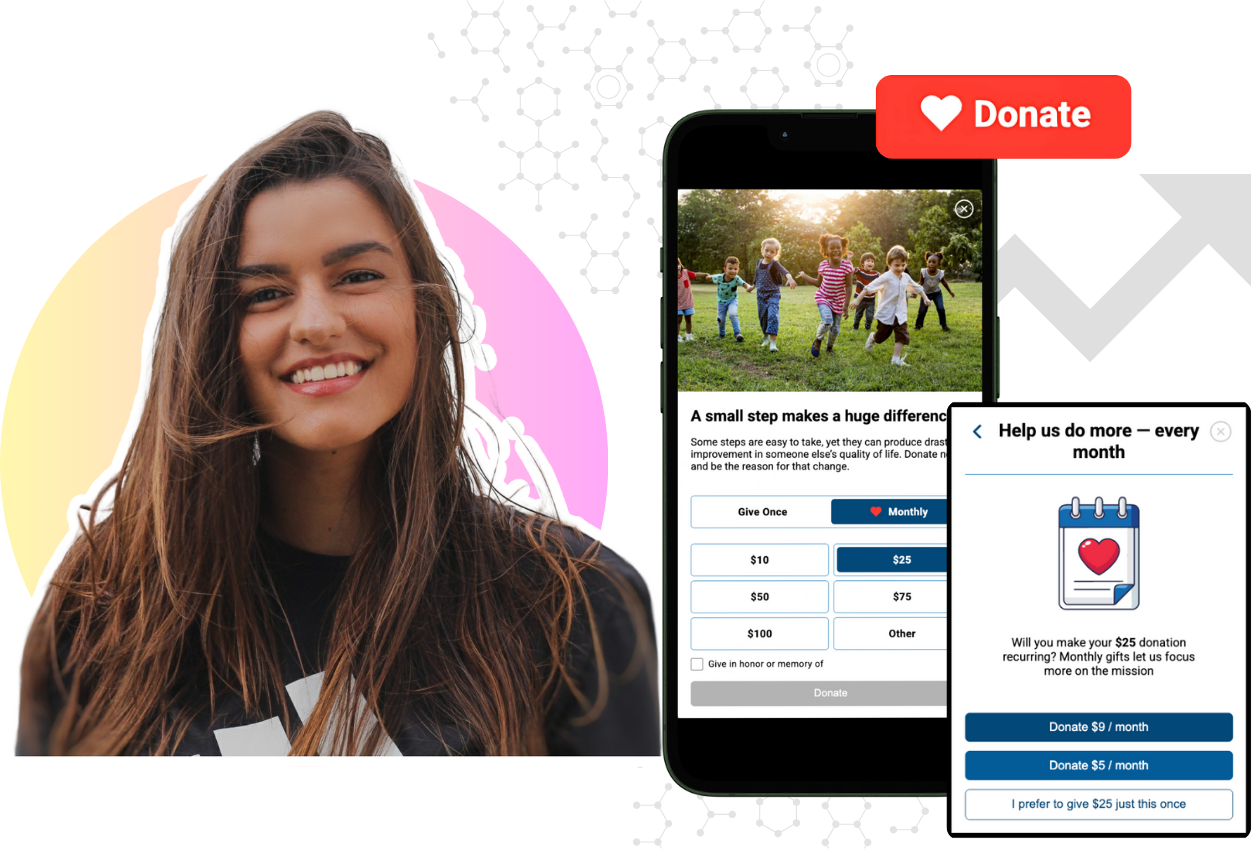Meet Donors Where They Want to Give: Online
Most people are generous by nature.

Mobile-First Pop-Up Donation Form
Launch mobile-first pop-up forms in minutes, use built-in tools to capture more donations, and optimize the giving experience—no dev team required.
New to online donation pages for your nonprofit? Start here.
Donation page A/B testing - no science degree needed.
Keep your donation page loading fast - and drive higher conversions.

The 4 Types of Online Donation Experiences
89% of donors leave without giving. Learn how to use the right donation form to close the gap and boost conversions.

Donor centricity is the principle that is first in line for building a Connected Giving experience. Your end goal is to increase online donations. But to do so, it must start with a commitment that will impact every aspect of your nonprofit, strategy, technology, business processes, operations, and marketing. Unfortunately, many are not ready for this level of commitment and will sadly continue to attempt to tactically solve their challenges.
This is something that happens regularly in everyday business. If you’ve ever tried to call customer service for anything, you know how annoying it can potentially be. Even after you explain the problem, the person on the other line says, “I am going to transfer you to a different department and they can help you out.” Already frustrated, you are left wondering why they can’t just handle the problem where you already are?
For those of us that serve donors or customers, we may not realize how difficult we make it for them. We have been looking through the wrong lens.
The essence of being donor centric is to view all decisions through the eyes of your donor. It’s about their efficiency and making their experience better, not yours. In the for-profit world there are many examples, but probably one of the best is Zappos. Every decision they make about the experience of buying shoes and clothing is viewed through the customer lens. Not only do they offer 100% free shipping and a full-year return policy, the cost they take in from the return shipping is actually seen as a Loyalty and Marketing expense. They view their customer support team as a central part of their business, and everything they do is meant to increase customer loyalty.
In the nonprofit world, there are many examples of where donor centricity applies. Let’s unpack one example – the giving form. It sounds incredibly simple, and one that is easily overlooked, but how quickly your donors find your donation page and how easy you make it for them to give can be a big factor. For the donor, it puts a pause on the experience if they have to hunt down where to give, and especially if they have any questions on security or reliability when inputting their information.
According to NextAfter, data shows that customers are more likely to donate (and more likely for you to increase online donations) if you provide any of the following donor-centric experiences with your giving form:
This is something we have innovated around here at iDonate. The form itself is customizable to your own brand. It is not one-size-fits-all, but instead matches your look and feel with your own colors and voice. What we call the “Gift Array,” you can edit the suggested amounts to make it easy for your donors to make a selection, but still give them the ability to type in their own gift amount. If they still have questions on where their money is going, you can add in what’s called an “Impact Equation,” one that says something like, “$10 provides 50 meals.”
Once they select the amount, the experience is then just like buying anything else online. After a simple input of payment information, click “Give Now,” and that’s it. The donor wouldn’t want to be taken to different screens and have to wonder if their payment will be secure. Being donor centric also means giving your donor peace of mind and making sure they understand the true benefit of their gift. Just like in the Zappos example, this can lead to increased loyalty and retention.
Keep in mind that being donor centric is a lot more than making a few tactical improvements on things like your giving form, but this one example is simply for you to begin thinking about this journey to help increase online donations. You may find many more of these to be carefully examined, and maybe changed. This is a big step, but it is the most important one in your journey to building trusted life-time donors.
1 How urgency language increases revenue
2 How a tangible reason to give impacted instant donor conversion
3 How adding suggested gift amounts affects donor conversion
4 How a one-column format donation page affects donor conversion rate
5 How communicating the specific kind of impact a person’s gift can have affects donor conversion
 Read More
Read More

In order to simplify online giving, you need to simplify the donor’s user experience. The majority of donors are already giving online, and many more...

Most nonprofits shy away from asking donors to give a second gift just weeks after their first donation. They fear their current donors will get...